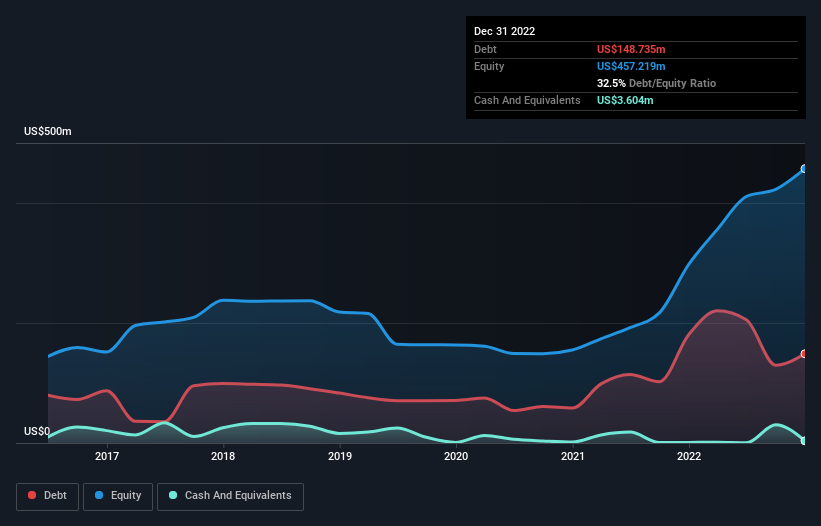- United States
- /
- Healthcare Services
- /
- NasdaqGS:CCRN
Is Cross Country Healthcare (NASDAQ:CCRN) Using Too Much Debt?

Legendary fund manager Li Lu (who Charlie Munger backed) once said, 'The biggest investment risk is not the volatility of prices, but whether you will suffer a permanent loss of capital.' When we think about how risky a company is, we always like to look at its use of debt, since debt overload can lead to ruin. We can see that Cross Country Healthcare, Inc. (NASDAQ:CCRN) does use debt in its business. But the real question is whether this debt is making the company risky.
What Risk Does Debt Bring?
Generally speaking, debt only becomes a real problem when a company can't easily pay it off, either by raising capital or with its own cash flow. If things get really bad, the lenders can take control of the business. However, a more common (but still painful) scenario is that it has to raise new equity capital at a low price, thus permanently diluting shareholders. By replacing dilution, though, debt can be an extremely good tool for businesses that need capital to invest in growth at high rates of return. When we examine debt levels, we first consider both cash and debt levels, together.
View our latest analysis for Cross Country Healthcare
What Is Cross Country Healthcare's Net Debt?
The image below, which you can click on for greater detail, shows that Cross Country Healthcare had debt of US$148.7m at the end of December 2022, a reduction from US$180.5m over a year. On the flip side, it has US$3.60m in cash leading to net debt of about US$145.1m.

A Look At Cross Country Healthcare's Liabilities
According to the last reported balance sheet, Cross Country Healthcare had liabilities of US$271.6m due within 12 months, and liabilities of US$219.0m due beyond 12 months. Offsetting this, it had US$3.60m in cash and US$653.7m in receivables that were due within 12 months. So it actually has US$166.7m more liquid assets than total liabilities.
This surplus suggests that Cross Country Healthcare is using debt in a way that is appears to be both safe and conservative. Given it has easily adequate short term liquidity, we don't think it will have any issues with its lenders.
We use two main ratios to inform us about debt levels relative to earnings. The first is net debt divided by earnings before interest, tax, depreciation, and amortization (EBITDA), while the second is how many times its earnings before interest and tax (EBIT) covers its interest expense (or its interest cover, for short). Thus we consider debt relative to earnings both with and without depreciation and amortization expenses.
Cross Country Healthcare has a low net debt to EBITDA ratio of only 0.49. And its EBIT covers its interest expense a whopping 19.5 times over. So you could argue it is no more threatened by its debt than an elephant is by a mouse. In addition to that, we're happy to report that Cross Country Healthcare has boosted its EBIT by 94%, thus reducing the spectre of future debt repayments. The balance sheet is clearly the area to focus on when you are analysing debt. But it is future earnings, more than anything, that will determine Cross Country Healthcare's ability to maintain a healthy balance sheet going forward. So if you're focused on the future you can check out this free report showing analyst profit forecasts.
But our final consideration is also important, because a company cannot pay debt with paper profits; it needs cold hard cash. So we clearly need to look at whether that EBIT is leading to corresponding free cash flow. Over the last three years, Cross Country Healthcare reported free cash flow worth 12% of its EBIT, which is really quite low. For us, cash conversion that low sparks a little paranoia about is ability to extinguish debt.
Our View
The good news is that Cross Country Healthcare's demonstrated ability to cover its interest expense with its EBIT delights us like a fluffy puppy does a toddler. But we must concede we find its conversion of EBIT to free cash flow has the opposite effect. It's also worth noting that Cross Country Healthcare is in the Healthcare industry, which is often considered to be quite defensive. Overall, we don't think Cross Country Healthcare is taking any bad risks, as its debt load seems modest. So the balance sheet looks pretty healthy, to us. The balance sheet is clearly the area to focus on when you are analysing debt. But ultimately, every company can contain risks that exist outside of the balance sheet. For example, we've discovered 1 warning sign for Cross Country Healthcare that you should be aware of before investing here.
At the end of the day, it's often better to focus on companies that are free from net debt. You can access our special list of such companies (all with a track record of profit growth). It's free.
New: AI Stock Screener & Alerts
Our new AI Stock Screener scans the market every day to uncover opportunities.
• Dividend Powerhouses (3%+ Yield)
• Undervalued Small Caps with Insider Buying
• High growth Tech and AI Companies
Or build your own from over 50 metrics.
Have feedback on this article? Concerned about the content? Get in touch with us directly. Alternatively, email editorial-team (at) simplywallst.com.
This article by Simply Wall St is general in nature. We provide commentary based on historical data and analyst forecasts only using an unbiased methodology and our articles are not intended to be financial advice. It does not constitute a recommendation to buy or sell any stock, and does not take account of your objectives, or your financial situation. We aim to bring you long-term focused analysis driven by fundamental data. Note that our analysis may not factor in the latest price-sensitive company announcements or qualitative material. Simply Wall St has no position in any stocks mentioned.
About NasdaqGS:CCRN
Cross Country Healthcare
Provides talent management and other consultative services for healthcare clients in the United States.
Flawless balance sheet with moderate growth potential.
Similar Companies
Market Insights
Community Narratives



